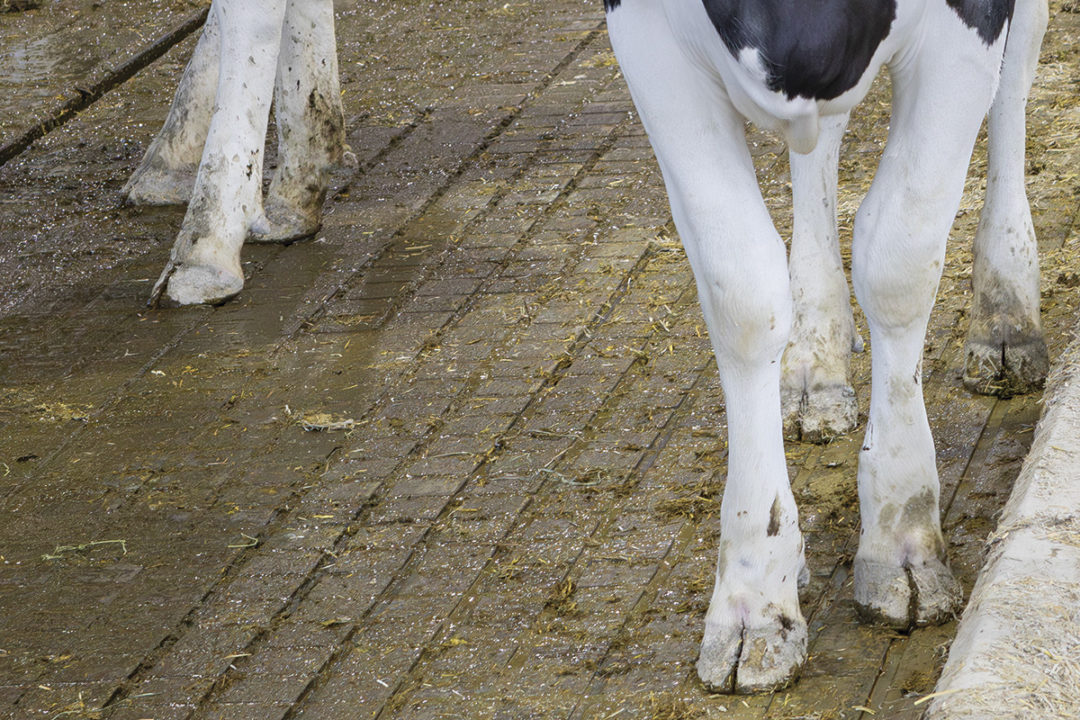To read this article in French, click here.
In dairy herds across the globe, feet and leg problems that typically lead to lameness consistently rank as one of the top culling reasons. Hoof lesions are the leading cause of lameness, impacting animal welfare and a farm’s bottom line due to decreased mobility, production and reproduction.
There are many ways to reduce the incidence of hoof lesions, whether it be through management strategies such as footbaths and preventive trimming, housing improvements including adequate bedding and traction, and nutrition strategies like balanced rations. However, selecting animals with a genetic predisposition for improved hoof health is a permanent and cumulative solution that can be used in conjunction with good herd management, housing and nutrition practices.
The Canadian genetic evaluation for Hoof Health was first introduced in 2017 for the Holstein breed, allowing producers to genetically improve their herd’s hoof health. Let’s answer some common questions about these evaluations.
What is included in the genetic evaluation for Hoof Health?
The genetic evaluation for Hoof Health promotes increased resistance to eight key foot lesions, namely digital dermatitis, interdigital dermatitis, heel horn erosion, sole ulcer, toe ulcer, white-line lesion, sole hemorrhage and interdigital hyperplasia. The inner circle of Figure 1 illustrates the relative weightings for each lesion within the Hoof Health Index. These weightings represent the prevalence and economic value of each lesion to producers.

Average incidence rates for each lesion are presented in Figure 2, with digital dermatitis continuing to be the most prevalent lesion at 13%, followed by sole ulcer and sole hemorrhage.

Correlations between genetic evaluations for the Hoof Health Index and the resistance to the eight lesions (outer ring of Figure 1) are all positive and range from 6% to 78%, with infectious diseases like digital dermatitis, interdigital dermatitis and heel horn erosion having the highest correlations. Moreover, Hoof Health is favourably correlated with most other evaluated traits including the two national selection indexes, Lifetime Performance Index (LPI) and Pro$, with an average correlation of 35%. This means that selection for either national selection indexes will result in improved Hoof Health.
How do I interpret Hoof Health?
Hoof Health is a functional trait expressed as a Relative Breeding Value (RBV) averaging 100 and ranging roughly between 85 to 115. The higher the RBV the better resistance to Hoof Health problems.
What does this mean for daughter performance? A bull with an average Hoof Health RBV of 100 is expected to have 75% healthy daughters, without any hoof lesions, in a typical herd. As the sire RBV increases, the percentage of healthy daughters does as well. Top sires rated 110 or better for Hoof Health are expected to have at least 9% more healthy daughters without any lesions than sires with an RBV of 100. On the other side, sires rated 90 or lower for hoof health are expected to have less than 60% healthy daughters without any lesions. To see how a bull’s daughters are expected to perform for each individual hoof lesion, one can consult the Health tab linked to their genetic evaluation summary page on the Lactanet website.
How can I contribute data?
The genetic evaluation for Hoof Health contains data directly provided by participating hoof trimmers via Hoof Supervisor software as well as DairyComp hoof trimming results. Although there has been a decline in the number of trimming records collected annually, this genetic evaluation must be sustained into the future by continued collection of lesion data.
At the time of trimming, Canadian dairy producers can submit their lesion data directly in the DairyComp herd management software or encourage their hoof trimmer to do so via Hoof Supervisor. In fact, herds contributing data will have Hoof Health evaluations that are more accurate and reliable compared to those not providing data.
A recent analysis conducted at Lactanet found that herds with lesion data in the evaluation system will achieve average Hoof Health reliabilities of 73% for their genotyped cows. This is nine percentage points higher than genotyped cows with no hoof trimming data available. For non-genotyped cows, reliabilities increase by six percentage points from 28% for cows with no data to 34% for cows with data. By contributing data to genetic evaluations for Hoof Health, one can be more confident in their cows’ evaluations.
Dairy producers recognize the importance hoof health plays in maintaining the welfare and production of their herd and use the wealth of preventative strategies to reduce the incidence of hoof lesions. Genetically selecting for animals with superior hoof health is one such strategy that can lead to long-term improvements.











